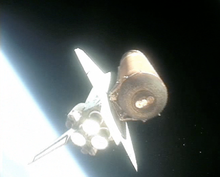- Orbital spaceflight
-
An orbital spaceflight (or orbital flight) is a spaceflight in which a spacecraft is placed on a trajectory where it could remain in space for at least one orbit. To do this around the Earth, it must be on a free trajectory which has an altitude at perigee (altitude at closest approach) above 100 kilometers (62 mi) (this is, by at least one convention, the boundary of space). To remain in orbit at this altitude requires an orbital speed of ~7.8 km/s. Orbital speed is slower for higher orbits, but attaining them requires higher delta-v.
The expression "orbital spaceflight" is mostly used to distinguish from sub-orbital spaceflights, which are flights where apogee of a spacecraft reaches space but perigee is too low.
Contents
Orbital launch
Orbital Human spaceflight Name Debut Launches Vostok 1961 6 Mercury 1962 4 Voskhod 1964 2 Gemini 1965 10 Soyuz 1967 110 Apollo 1968 15 Shuttle 1981 135 Shenzhou 2003 3 Orbital spaceflight from Earth has only been achieved by launch vehicles that use rocket engines for propulsion. To reach orbit, the rocket must impart to the payload a delta-v of about 9.3–10 km/s. This figure is mainly (~7.8 km/s) for horizontal acceleration needed to reach orbital speed, but allows for atmospheric drag (approximately 300 m/s with the ballistic coefficient of a 20 m long dense fuelled vehicle), gravity losses (depending on burn time and details of the trajectory and launch vehicle), and gaining altitude.
The main proven technique involves launching nearly vertically for a few kilometers while performing a gravity turn, and then progressively flattening the trajectory out at an altitude of 170+ km and accelerating on a horizontal trajectory (with the rocket angled upwards to fight gravity and maintain altitude) for a 5-8 minute burn until orbital velocity is achieved. Currently, 2-4 stages are needed to achieve the required delta-v. Most launches are by expendable launch systems.
The Pegasus rocket for small satellites instead launches from an aircraft at an altitude of 12 km.
Other techniques, such as use of a launch loop, have been proposed for non-rocket spacelaunch. These techniques are theoretical: no attempts have been made to orbit a vehicle using any of them.
Stability
 The International Space Station during its construction in Earth orbit in 2001. It must be periodically re-boosted to maintain its orbit
The International Space Station during its construction in Earth orbit in 2001. It must be periodically re-boosted to maintain its orbit
An object in orbit at an altitude of less than roughly 200 km is considered unstable due to atmospheric drag. For a satellite to be in a stable orbit (i.e. sustainable for more than a few months), 350 km is a more standard altitude for low Earth orbit. For example, on 1958-02-01 the Explorer 1 satellite was launched into an orbit with a perigee of 358 kilometers (222 mi).[1] It remained in orbit for more than 12 years before its atmospheric reentry over the Pacific Ocean on 1970-03-31.
However, the exact behaviour of objects in orbit depends on altitude, their ballistic coefficient, and details of space weather which can affect the height of the upper atmosphere.
Orbits
Main article: Geocentric orbitThere are three main 'bands' of orbit around the Earth: low Earth orbit (LEO), medium Earth orbit (MEO) and geostationary orbit (GEO).
Due to Orbital mechanics orbits are in a particular, largely fixed plane around the Earth, which coincides with the center of the Earth, and may be tilted with respect to the equator. The Earth rotates about its axis within this orbit, and the relative motion of the spacecraft and the movement of the Earths surface determines the position that the spacecraft appears in the sky from the ground, and which parts of the Earth are visible from the spacecraft.
By dropping a vertical down to the Earth's surface it is possible to calculate a ground track which shows which part of the Earth a spacecraft is immediately above, and this is useful for helping to visualise the orbit.
NASA provides real-time tracking of the over 500 artificial satellites maintained in orbit around Earth. For the position of these satellites see NASA satellite tracking.
Deorbit and re-entry
Main article: Atmospheric entryReturning spacecraft (including all potentially manned craft) have to find a way of slowing down as much as possible while still in higher atmospheric layers and avoid hitting the ground (lithobraking) or burning up. For many orbital space flights, initial deceleration is provided by the retrofiring of the craft's rocket engines, perturbing the orbit (by lowering perigee down into the atmosphere) onto a suborbital trajectory. Many spacecraft in low-Earth orbit (e.g., nanosatellites or spacecraft that have run out of station keeping fuel or are otherwise non-functional) solve the problem of deceleration from orbital speeds through using atmospheric drag (aerobraking) provide initial deceleration. In all cases, once initial deceleration has lowered the orbital perigee into the mesosphere, all spacecraft lose most of the remaining speed, and therefore kinetic energy, through the atmospheric drag effect of aerobraking.
Intentional aerobraking is achieved by orienting the returning space craft to fly so as to present the heat shields forwards towards the atmosphere so as to protect against the high temperatures generated by atmospheric compression and friction caused by passing through the atmosphere at hypersonic speeds. The thermal energy is dissipated mainly by compression heating the air in a shockwave ahead of the vehicle using a blunt heat shield shape, with the aim of minimising the heat entering the vehicle.
Sub-orbital space flights, being at a much lower speed, do not generate anywhere near as much heat upon re-entry.
Even if the vehicle is a satellite that is ultimately expendable, most space authorities are pushing towards controlled re-entry techniques to avoid issues of space debris reaching the ground and causing a hazard to lives and property. In addition, this minimises the creation of orbital space junk.[citation needed]
History
- Sputnik 1 was successfully launched on October 4, 1957 by the Soviet Union
- Vostok 1, launched by the Soviet Union on April 12, 1961, carrying Yuri Gagarin, was the first successful human spaceflight to reach Earth orbit.
See also
- Orbit
- List of orbits
- Ground track
- Orbital mechanics
- Project HARP was a failed attempt, and a ram accelerator is another design, to launch an object into orbit with a gun
- Rocket launch
- Non-rocket spacelaunch
- Spacecraft
- Spaceflight
- Spaceport, including a list of sites for orbital launches
References
- ^ "Explorer 1 - NSSDC ID: 1958-001A". NASA. http://nssdc.gsfc.nasa.gov/nmc/masterCatalog.do?sc=1958-001A.
External links
Spaceflight General 
Applications Earth observation satellites (Spy satellites · Weather satellites) · Private spaceflight · Satellite navigation · Space archaeology · Space architecture · Space colonization · Space exploration · Space medicine · Space tourismHuman spaceflight GeneralHazardsMajor projectsApollo · Constellation · Gemini · International Space Station · Mercury · Mir · Shenzhou · Soyuz · Space Shuttle · Voskhod · VostokSpacecraft Destinations Space launch Space agencies Categories:- Spaceflight
- Russian inventions
Wikimedia Foundation. 2010.

